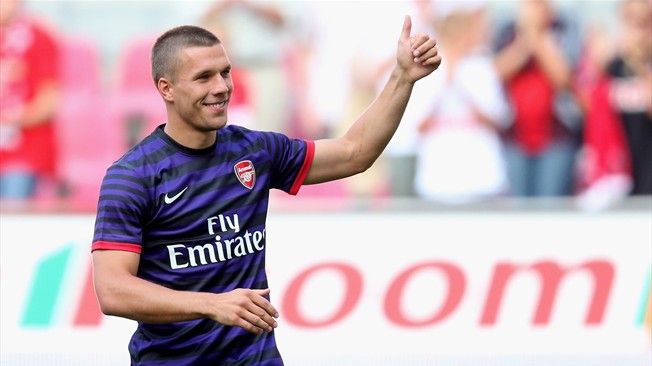After Arsenal’s victory over Everton in the FA Cup last weekend, ITV’s Adrian Chiles seemed shocked that the Gunners didn’t fall flat on their face as, according to him, they always do come springtime.
To be fair, he’s not totally wrong. Between the years of 2008 and 2011 in particular, Arsenal had something of a knack for falling out of all competitions in the space of a few weeks, and thus seeing their season completely unravel. Therefore it was not unreasonable for Chiles and the like to expect something similar in that particular game with the Gunners down in their European tie with Bayern Munich, and falling away from Chelsea in the title race.
Although I think this is another cheap, lazy narrative that the media feel obliged to follow, there is of course an element of truth in it. But why do Arsenal seem to collapse in this manner? It has long been suggested that they don’t have the mental fortitude to cope, but I’d argue that in the last few campaigns they’ve developed a far stronger resolve. Certainly this season they’ve quickly bounced back from disappointing results at Manchester City and Liverpool in particular.
With Mesut Özil becoming the latest in a long line of casualties, perhaps it’s simply injuries that are the biggest problem. Whilst I have no information as to Arsenal’s training methods or medical techniques, their record over the last decade or so in the injury department has been appalling and surely something has to change. Indeed new staff have come in, but the issue has never really gone away. To my amateur eye, it simply seems like the Arsenal squad is too reliant on the same individuals, therefore they get overplayed and pick up niggling injuries.
Özil is joined on the treatment table by Aaron Ramsey, Theo Walcott, Kieran Gibbs and Jack Wilshere as well as forgotten man Abou Diaby, who I dare suggest we may never see play for Arsenal again. Bizarre deadline day signing Kim Källström is now available but unlikely to play a big part in the remainder of Arsenal’s season. As a result, the players that are fit are having to step up.
Alex Oxlade-Chamberlain has emerged as quite the player in recent weeks. Cruelly injured on the opening day of the season, ‘the Ox’ was ruled out for almost five months but has been nothing short of spectacular since returning from his lay-off. Oxlade-Chamberlain has long been compared with teammate fellow Southampton academy graduate Walcott but is very much a different player.
He picks the ball up deeper and drives at defenders, whereas Walcott likes to receive passes from the midfield and run in behind. Oxlade-Chamberlain has been earmarked as a future central midfielder, and has performed well in that role, but is filling the badly-missed shoes of Walcott quite efficiently.
Oxlade-Chamberlain was by far the most threatening Arsenal player on a tricky evening at the Allianz Arena, and you could conceivably argue that he has been the stand-out individual in each game he’s appeared in since returning. Against Everton he was terrific; even on a couple of occasions where he lost the ball, he hounded his opponent to cleanly win the ball back, much to the fans’ appreciation.
The likes of Raheem Sterling have impressed this season, but Oxlade-Chamberlain appears to be England’s most promising talent by some distance. He’s freakishly balanced and composed on the ball, confident yet down-to-earth and is slowly becoming more and more effective in the final third. This has certainly been something of a breakthrough season for him and he can now easily consider himself one of the first names on the Arsenal teamsheet.
Lukas Podolski is another that will be thrust into the limelight in the remaining months of the season. The German has endured a mixed time at Arsenal. His first season was generally positive, as he scored a respectable 16 goals in all competitions and seemed to adapt to the notoriously physical nature of the Premier League. He has struggled for game time in his second campaign, however, usually being limited to substitute appearances; only ever seeming to start in the FA Cup.
He did, however, play from the beginning in Munich where he turned in arguably his best performance since joining in 2012. Podolski rattled home a trademark strike to give the Gunners hope against his former team and linked with his fellow forward players with far more intensity than he has in previous months. With better support from his teammates, there could have been more goals in the game for him.

Many feel that Podolski is something of a square peg in a team full of round holes. His tendency to go missing for large periods of the game make him a frustrating figure, one whose movement is not as sophisticated as Walcott’s, for example, and consequently a lot of people expect him to be sold in the summer.
However, I’d be inclined to argue that Podolski’s inconsistency was partly down to his own injury which kept him out for the best part of three months at the start of the season. The 28-year-old has started three of the last four games which suggests Arsène Wenger feels Podolski is finally back to full fitness or – to play devil’s advocate – has little choice but to play him.
Yet for his flaws, Podolski is an invaluable asset to the team because of his finishing. Plenty of Arsenal players are capable of putting the ball in the net, but none do it with the authority of Podolski, who is as clinical in front of goal as they come. His left foot is an absolute hammer, making him capable of scoring from anywhere.
He’s far from tactically perfect but adds a lot to the team on his day and, especially with the dwindling number of options, simply has to play as much as possible. As we enter the so-called business end of the season, the form of Oxlade-Chamberlain and Podolski could prove crucial in Arsenal’s bid to end their well-documented trophy drought.

